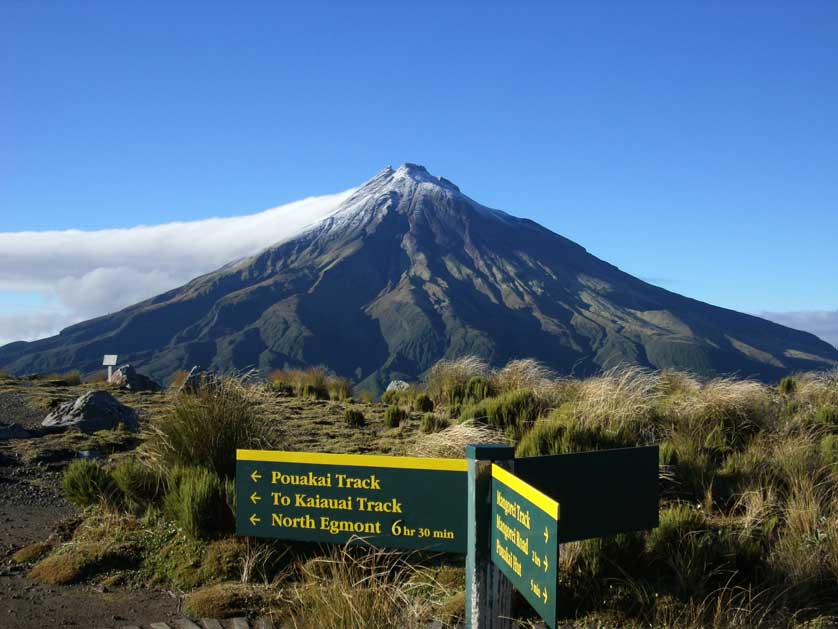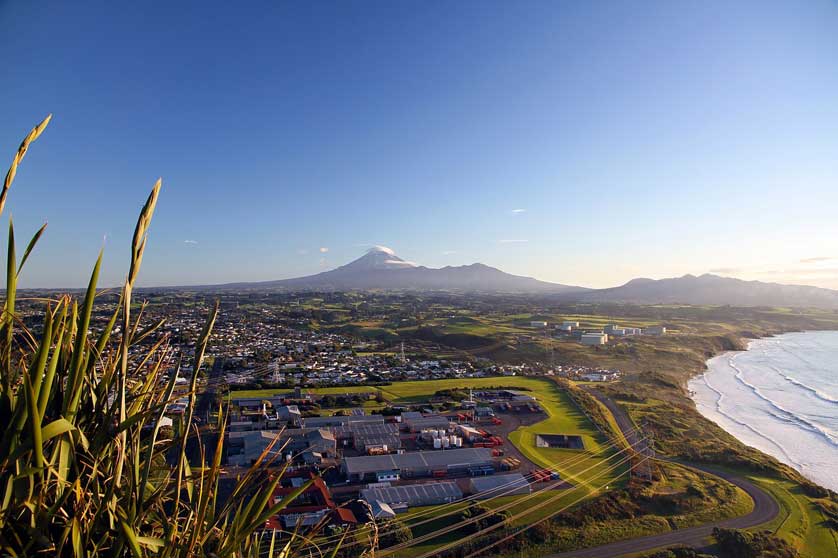Egmont National Park (Te Papa-Kura-o-Taranaki), New Zealand
 |
| Mount Taranaki (Mount Egmont) |
Egmont National Park, now also known as Te Papa-Kura-o-Taranaki, lies close to the west coast of the North Island near the town of New Plymouth. It was the second of New Zealand's 13 national parks to be created in the country in 1900 after Tongariro in 1887.
It comprises a forest reserve around the base of a presently dormant volcano, Mount Taranaki (Mount Egmont), with very high annual rainfall. The weather conditions have resulted in the growth of the broadleaf rain forest, marked by a total absence of beech trees.
The park covers an area of over 341 square kilometres.
 |
| Taranaki from the Pouakai Circuit tramping track |
Attractions
At 2,518 metres Mount Taranaki is the second highest mountain in the North Island. Captain Cook named the mountain Mount Egmont but this was changed to its Maori name in 1986. The mountain is the centerpiece of the national park. It is an active stratovolcano with a perfectly symmetrical cone-shaped peak. Hiking to the summit is a popular activity for experienced climbers, but there are also many well-marked trails of varying difficulties for visitors to enjoy. Due to its resemblance to Mount Fuji in Japan, Taranaki provided the backdrop for the 2003 film The Last Samurai, starring Tom Cruise.
The Pouakai Crossing day hike is considered one of New Zealand's best day walks. It takes you through a diverse range of landscapes, including lush forests, subalpine terrain, and open tussock lands. The trail offers breathtaking panoramic views of Mount Taranaki and the surrounding countryside, as well as the stunning Pouakai Ranges.
Located on the southern slopes of Mount Taranaki, Dawson Falls is a picturesque waterfall surrounded by beautiful native bush. You can reach it via an easy walk from the visitor center and enjoy the tranquil surroundings
A series of natural rock pools and waterfalls, Wilkies Pools is a popular spot for a refreshing dip or a picnic. The crystal-clear waters and serene atmosphere make it an ideal place to relax and enjoy the surrounding nature.
 |
| Taranaki Maunga is New Zealand's most perfectly shaped volcano |
Goblin Forest is characterized by its dense growth of gnarled and twisted kamahi trees, draped with lush moss and ferns. Walking through the forest feels like stepping into a magical world, and it provides excellent photo opportunities.
Pouakai Tarns are a group of small alpine lakes that offer stunning reflections of Mount Taranaki. The tarns can be reached via a hike from Mangorei Road and provide a fantastic spot for photography.
Located at an elevation of around 1,500 meters (4,900 feet), the Stratford Plateau is the starting point for those attempting to summit Mount Taranaki. It offers fantastic views and is a popular spot for camping.
The Department of Conservation (DOC) Visitor Centre is at 2879 Egmont Road (PO Box 462 New Plymouth 4340). Tel: 06 756 0990; 8.30 am to 4.30 pm daily.
Accommodation
New Plymouth offers a variety of accommodation and eating options.
Try The Devon Hotel with a heated outdoor pool and free use of mountain bikes.
The modern Novotel New Plymouth Taranaki has an onsite restaurant and bar.
The Plymouth International provides both air conditioning and cable TV.
Find accommodation in New Plymouth.
Access - Getting There
The fastest and most convenient way to reach New Plymouth from Wellington is by air. You can book a domestic flight from Wellington International Airport (WLG) to New Plymouth Airport (NPL). The flight duration is approximately 45 minutes. From Auckland Airport (AKL) to New Plymouth Airport the flight duration is approximately 1 hour and 15 minutes.
If you prefer to drive, you can take State Highway 1 (SH1) from Wellington to Bulls, then switch to State Highway 3 (SH3) and continue north to New Plymouth. The approximate driving distance is around 355 kilometers (220 miles), and the journey takes about 4.5 to 5 hours, depending on traffic and road conditions. From Auckland take State Highway 1 (SH1) and continue south until you reach State Highway 3 (SH3). Take SH3 towards New Plymouth, the approximate driving distance is around 350 kilometers (220 miles). The journey takes about 4.5 to 5 hours, depending on traffic and road conditions.
Several bus companies operate services between Wellington and New Plymouth. Intercity and Skip Bus are two popular options. The bus journey takes around 6 to 7 hours, depending on the route and stops. It is advisable to check the schedules and book your tickets in advance. The bus from Auckland takes around 6 to 7 hours, depending on the route and stops.
You can also combine a train and bus journey to reach New Plymouth from Wellington. Take the Northern Explorer train from Wellington Railway Station to Palmerston North, and from there, catch a connecting bus to New Plymouth. The total travel time can vary but generally takes around 7 to 8 hours.
 |
| Due to its resemblance to Mount Fuji in Japan, Taranaki provided the backdrop for the 2003 film The Last Samurai |
Books on New Zealand





0 Comments